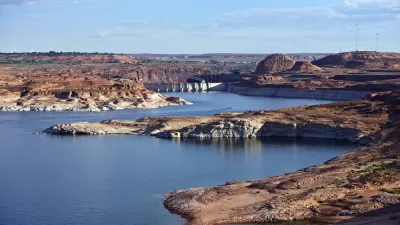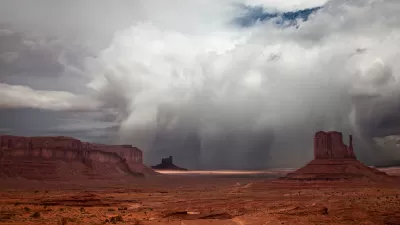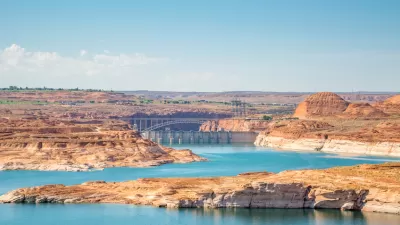Las Vegas has almost maximized its growth potential given projects for its future water supply—something has to give.

How big can Las Vegas grow before the water runs out?
That's the big question driving a deep investigation by The Las Vegas Review-Journal that includes nine installments in the series and two interactive features. Henry Brean does the writing.
At the center of the big report is the Colorado River, and one could say the story is about the Colorado River more than Las Vegas. Despite Nevada receiving the least water from the Colorado River of any of the seven states in the river's watershed (and Mexico), Las Vegas relies the most on Colorado River water of any large city.
As is well documented in the series and by many journalists in the Southwest, the Colorado River watershed is reeling from the effects of a 20-year drought, and two of the major storage facilities along the river, Lake Mead and Lake Powell have reached historic lows. A major collaborative effort has recently been approved by the Colorado River states, called the Drought Contingency Plan, or DCP by those involved in the process. The water chiefs of seven U.S. states (Arizona, California, Colorado, Nevada, New Mexico, Utah, and Wyoming) recently penned an op-ed for the Desert Sun urging Congress to approve the DCP. The DCP took significant effort and overcame many obstacles and setbacks to reach this point, but the need for such a plan couldn't be greater. Climate change models show rainfall and water supply decreasing in the watershed in the future—meaning all of the end users in the system will have to make due with less while keeping the river alive for environmental, cultural, and economic reasons.
For urban planners, Part 9 in the series raises the most broadly relevant questions about how Las Vegas can plan for growth with the existing and future water supplies. In that installment of the series, Bream says the question of how large Las Vegas given its water supply is tough to answer given the variables of drought, policy, and population growth. "But if it’s numbers you want, here’s one for you: 2,554,000," writes Bream. "That is the number of people the authority believes it can serve with the existing water supply if Las Vegas booms just as everything goes wrong on the Colorado River." For those keeping track at home, that's only 300,000 more than the city's current population.
For more on how the report came together, Kristen Hare reports on Brean's journalistic process for Poynter.
FULL STORY: The Water Question

Alabama: Trump Terminates Settlements for Black Communities Harmed By Raw Sewage
Trump deemed the landmark civil rights agreement “illegal DEI and environmental justice policy.”

Study: Maui’s Plan to Convert Vacation Rentals to Long-Term Housing Could Cause Nearly $1 Billion Economic Loss
The plan would reduce visitor accommodation by 25% resulting in 1,900 jobs lost.

Why Should We Subsidize Public Transportation?
Many public transit agencies face financial stress due to rising costs, declining fare revenue, and declining subsidies. Transit advocates must provide a strong business case for increasing public transit funding.

Paris Bike Boom Leads to Steep Drop in Air Pollution
The French city’s air quality has improved dramatically in the past 20 years, coinciding with a growth in cycling.

Why Housing Costs More to Build in California Than in Texas
Hard costs like labor and materials combined with ‘soft’ costs such as permitting make building in the San Francisco Bay Area almost three times as costly as in Texas cities.

San Diego County Sees a Rise in Urban Coyotes
San Diego County experiences a rise in urban coyotes, as sightings become prevalent throughout its urban neighbourhoods and surrounding areas.
Urban Design for Planners 1: Software Tools
This six-course series explores essential urban design concepts using open source software and equips planners with the tools they need to participate fully in the urban design process.
Planning for Universal Design
Learn the tools for implementing Universal Design in planning regulations.
Smith Gee Studio
Alamo Area Metropolitan Planning Organization
City of Santa Clarita
Institute for Housing and Urban Development Studies (IHS)
City of Grandview
Harvard GSD Executive Education
Toledo-Lucas County Plan Commissions
Salt Lake City
NYU Wagner Graduate School of Public Service





























